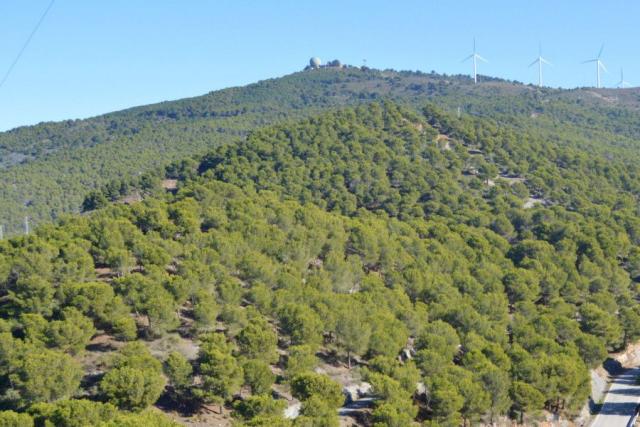You will find a dense mass of smaller leaves or needles at the top of some pine trees also known as “witches' broom”, a disease caused by some bacteria that infect the inner heartwood of the tree.
Rockroses are among the most significant shrubs occurring in this area. They have opposite leaves and attractive flowers with numerous stamens, soft pinks or white petals and capsule-like fruits. There you will find three different types of rockroses:
- White-leaved Rockrose (Cistus albidus). It has pale greyish green, velvet-like leaves and pink flowers. This species can spread quickly over recently burnt areas of land and for that reason, they are known as “daughters of fire”.
- Montpellier cistus (Cistus monspeliensis). It has narrow dark-green leaves and white flowers. This species does not tolerate alkaline soil and that is the reason why it is known as “calcifuge plant”.
- Romero macho (Cistus clusis). They have long narrow with curled edges similar in appearance to a rosemary, but they have small white flowers. They usually prefer relatively lime rich soils and, therefore, they are described as “calcicole plants”.
A repopulation of Aleppo pine trees and some cypresses are commonly found in this place. In certain areas, you will also find species of the Mediterranean forest like the cork oak (Quercus suber), holm oak (Quercus ilex), Mediterranean buckthorn (Rhamnus alaternus), tree germander (Teucrium fruticans) or blackthorn (Prunus spinosa).
The most representative tree native species of the Mediterranean forest are those within the genus Quercus that produce small fruits called acorns. It is worth mentioning:
- Holm oak (Quercus ilex), It has small, tough and spiny leaves which are dark-green on the upper side and pale grey on the underside. It bears sweet acorns.
- Kermes oak (Quercus coccifera). It is a shrub species with green leaves on both sides and spiny. It bears bitter acorns.
- Cork oak (Quercus suber). It is similar in appearance to a Holm oak, but the bark covering the trunk and branches is composed of cork.
- Portuguese oak (Quercus faginea). With broader and less tough leaves, it is the only one that loses its leaves in winter (deciduous tree). It occurs in high mountains in damp shady areas. It is less drought-resistant than the above mentioned species.
This journey begins one kilometre before reaching the Fuente del Moral (Gualchos-Lújar road). After a few hundred metres walking, you will reach a junction with a cypress in the middle. At the roundabout, the path to the left will take you to the Forest Ranger house located 500 metres (1,640.42 feet) away and the path to the right will lead you to a pine trees repopulation area. Continue along the main path which climbs across the hillside that sits besides the gully of Las Fuentezuelas. The trail continues until you reach a river bed where you will have the opportunity to see Mediterranean tree species (Cork oak, Holm oak, Mediterranean buckthorn, tree germander or blackthorn). Later on, you will get to walk through an abandoned almond orchard. Continuing across the forest path, the route will take you along a bunch of pine trees and shrubs located just below a cell tower. After a few hundred metres walking, the trail winds up at the Cortijo de Alcántara.
From the Forest Ranger house called Fuente del Moral, the views out across the surrounding landscape of Carchuna are quite breathtaking. There you will find an information panel called “Mirador de los llanos de Carchuna” (Viewpoint of Carchuna). Halfway, you will also find an information panel called “El bosque mediterráneo” (The Mediterranean forest).
You will access this trail from the road Gualchos-Lujar, one kilometre before reaching the Fuente del Moral and once you have reached the Forest Ranger house, continue the trail that runs along the western hillside of Cerro del Conjuro.
Crossing the final stretch of the trail, after passing through the cell tower near the gully, the path winds up at the Cortijo de Alcántara.
This route leads into the “Garnatilla-Alcantara” trail.

